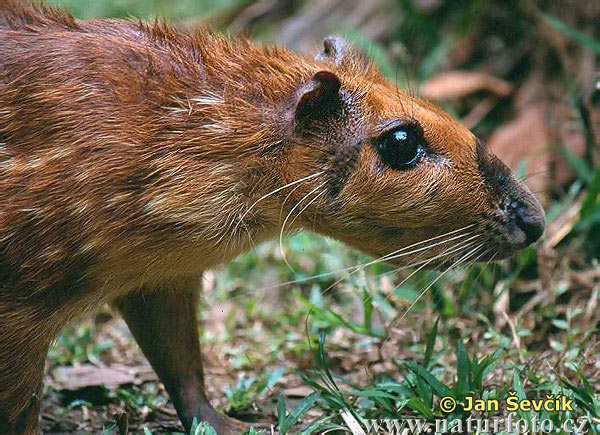
http://en.wikipedia.org/wiki/Paca
http://animals.jrank.org/pages/3469/Pacas-Agoutidae-PACA-Agouti-paca-SPECIES-ACCOUNT.html
MAMMALIAN SPECIES N0. 404, pp. H, 3 fig. Agouti paca.
http://www.helium.com/items/1732375-rodent-facts-paca
http://www.belizemagazine.com/edition07/english/e07_30fauna.htm
http://www.mobot.org/plantscience/ccsd/programs/cb/cbcloc/peru.shtml
Curry Labba
http://www.flickr.com/photos/eatingintranslation/3899397028/
http://www.flickr.com/photos/eatingintranslation/3898613157/in/photostream/
Risk
http://www.ncbi.nlm.nih.gov/pubmed/15667717
Videos
http://www.youtube.com/watch?v=lOj0SAdJRpA
http://www.youtube.com/watch?NR=1&feature=endscreen&v=WODv2IEjcGA
Cooking Agouti
http://www.youtube.com/watch?v=NBnYCJgl2dg&feature=related
Domestication and husbandry of the paca (Agouti paca). 1995. FAO Conservation Guide No. 26. Rome, FAO.
 In line with FAO's mandate to assist countries in achieving food security, in
which forest resources play a significant role, the Forestry Department is
working to document and spread technical expertise on the domestication of
wildlife species which can have a real impact on improving food availability to
rural dwellers throughout the world.
An excellent candidate for such domestication is the paca (Agouti
paca), which is native to Latin American lowland forests from southern
Mexico to southern Brazil. Because of the highly preferred meat of the paca,
local people in many countries of Latin America have attempted for many years to
raise it in captivity, but this has not proved to be practical because pacas
normally live only in pairs, are naturally aggressively territorial and
extremely socially intolerant. Moreover, they have a low reproductive rate so,
with the need for a separate cage for each reproductive female, there has been
little hope that, even though they will breed in captivity, the endeavour will
be economically feasible.
An experimental programme to domesticate pacas was carried out at the
Smithsonian Tropical Research Institute in Panama between 1983 and 1990. By
taking advantage of a critical-period learning phenomenon (similar to
"imprinting") that occurs in infant pacas, it has been possible to alter their
socialization process completely so that they are changed in one generation into
social, easily handled, "domesticated" animals. The young born in groups of
experimentally socialized pacas learn the behaviour of their parents and do not
revert to that of their wild antecedents. Their reproductive potential is still
low but, because they can be kept in mixed sex groups, the economy of paca
raising has been greatly improved.
This document presents information in a step-by-step format that will allow
easy replication of the domestication process that was successful in the
Smithsonian programme. In this respect, it will be of primary value to resource
managers in Latin America; however, it could also be of value to technicians in
Africa where the grasscutter (Thryonomys swinderianus) occupies a similar
ecological and nutritional niche to the paca in Latin America.
In line with FAO's mandate to assist countries in achieving food security, in
which forest resources play a significant role, the Forestry Department is
working to document and spread technical expertise on the domestication of
wildlife species which can have a real impact on improving food availability to
rural dwellers throughout the world.
An excellent candidate for such domestication is the paca (Agouti
paca), which is native to Latin American lowland forests from southern
Mexico to southern Brazil. Because of the highly preferred meat of the paca,
local people in many countries of Latin America have attempted for many years to
raise it in captivity, but this has not proved to be practical because pacas
normally live only in pairs, are naturally aggressively territorial and
extremely socially intolerant. Moreover, they have a low reproductive rate so,
with the need for a separate cage for each reproductive female, there has been
little hope that, even though they will breed in captivity, the endeavour will
be economically feasible.
An experimental programme to domesticate pacas was carried out at the
Smithsonian Tropical Research Institute in Panama between 1983 and 1990. By
taking advantage of a critical-period learning phenomenon (similar to
"imprinting") that occurs in infant pacas, it has been possible to alter their
socialization process completely so that they are changed in one generation into
social, easily handled, "domesticated" animals. The young born in groups of
experimentally socialized pacas learn the behaviour of their parents and do not
revert to that of their wild antecedents. Their reproductive potential is still
low but, because they can be kept in mixed sex groups, the economy of paca
raising has been greatly improved.
This document presents information in a step-by-step format that will allow
easy replication of the domestication process that was successful in the
Smithsonian programme. In this respect, it will be of primary value to resource
managers in Latin America; however, it could also be of value to technicians in
Africa where the grasscutter (Thryonomys swinderianus) occupies a similar
ecological and nutritional niche to the paca in Latin America. 
No comments:
Post a Comment